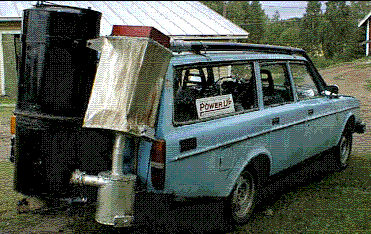
 Vehicles
Vehicles
The components of the wood gas equipment are quite big and when installed on a
vehicle they often reduce visibility. The performance of the vehicle is not as good as
with a gasoline engine and the driver must adjust the system every now and then. Using
and maintaining the equipment is not without risk. Safety aspects must be noted. The
users must be trained well to use the equipment. Special attention must be paid to the
risk of poisoning.
In general the installation on vehicles of different types can be made in the following
way:
- in a truck the generator is installed behind the cabin. Auxiliary fuel can be placed
on the cabin roof.
- in a car the equipment is installed on a trailer. Auxiliary fuel can also be placed on
the trailer. The load capacity of the car is not reduced much and the car can be used
with gasoline, if available.
- in a tractor the generator is usually installed on the left hand side. The filter can be
installed in the front. The cooler is installed in the front of the radiator to ensure
sufficient cooling also when used stationary. Auxiliary fuel can be stored for
example on the roof of the cabin.
The gas generator must be installed firmly in vertical position. Other parts and the load
must be thermally insulated from the generator. The temperature of the outer surface of
the generator can be up to 300°C. The intake air for the generator must be taken from the
hottest possible place for example in the vicinity of the exhaust manifold. This increases
the heating power of the gas and improves fuel drying. The starting gas output pipe must
be aligned so that the gas can not enter the cabin.
- Spark trap
- If the spark trap (cyclone) is not thermally insulated the temperature of the outer
surface can raise to 400°C. When the spark trap is properly insulated there is no
risk for a fire.
-
- Filter
- When the filter is thermally insulated its outer surface is not hot. The filter must be
secured firmly. An important point to notice in design and installation is easy
maintenance: easy removal of ash and easy cleaning of the filter element. The
maximum temperature of the gas entering the filter is 400°C.
-
- Cooler
- The cooler is designed to match the dimensions of the vehicle's own radiator and
installed as close to it as possible to make sure that the air flow generated by the
radiator fan ensures good cooling when used stationary. If the cooler can not be
installed in the front of the radiator a separate cooling fan is needed. In a car the air
flow generated by the driving speed is sufficient to provide proper cooling. The
temperature of the gas entering the cooler is about 350°C and the temperature of the
gas leaving the cooler is about 35°C.
-
- Distribution reservoir
- The distribution reservoir must be installed between the cooler and the mixer. The
proper volume for it is 10 liter and it must be filled with rolled expanded metal.
The distribution reservoir must be equipped with a draining plug or tap to make
draining the condensed liquids easy.
-
- Mixer
- The mixer is installed as close to the inlet manifold as possible. The mixer mixes
the fresh air and carbon monoxide. The mixture goes into the engine.
-
- Pipes
- The pipes must be as short and straight as possible. Especially curves bending
downwards must be avoided. The pipes must be gas tight and firm enough to
withstand the suction, heat and vibration. The pipes must be spacious to reduce the
suction resistance. The temperature of the gas flowing in the pipes varies in the
range of 30 - 450°C.
-
- Control levers
- Operating the control flaps for the mixture and power is best done with levers and
bars. The controls must be placed to be easily accessible in the cabin.
 Translated by Olli.
Translated by Olli.



![]()
 Translated by Olli.
Translated by Olli.